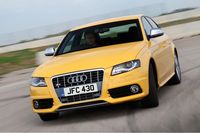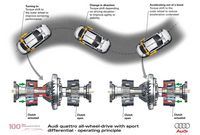New Audi S4 Raises the Benchmark for Handling Dynamics
MILTON KEYNES, UNITED KINGDOM – May 7, 2009: An advanced new high-tech driver aid from the inventors of quattro permanent four-wheel drive is now available in the UK in the new Audi S4. The new sports rear axle, which transforms quattro handling characteristics while retaining the inherent safety benefits of all-wheel-drive, makes its debut in the new supercharged performance Saloon and Avant, and will extend its influence further across the Audi range in the near future.
With its new active sport differential, Audi elevates the road dynamics of the new S4 quattro to a new level. A unique electronic regulating system distributes torque from the engine in continuously variable proportions left and right between the rear wheels, the resulting controlled power flow enabling the car to take corners even more responsively, and to retain its directional stability for considerably longer. With its help the potential for adjustment of the cornering line is much increased and understeer effectively becomes a thing of the past.
Six advances combine to create Audi S4 dynamics
Audi has
brought together a sequence of engineering and design advances for the
first time in the new S4 using unique technology to effect a transformation
in the car’s approach to high speed handling. The longer wheelbase of
the latest A4 range and its forward mounted axle are the first and second
elements, and help to establish the well-balanced basis of the chassis
layout. Thirdly, a more advanced 40:60(front/rear) power distribution via
quattro contributes to handling poise.
For the fourth stage Audi then adds its unique and advanced drive select system enabling the driver to select comfort-oriented or more dynamic settings influencing throttle, steering and suspension response to suit widely varying individual preferences. The most notable advance within drive select is the ability to increase effective steering rack speed.
The remarkable 7-speed double clutch S tronic gearbox configured especially for longitudinal or ‘north - south’ application is the fifth key ingredient. This rapid acting, highly-efficient transmission is equipped with shift paddles and reacts responsively in its close interaction with the engine. Downshifts for example generate an automatic ‘blip’ of the throttle.
Finally, the sixth advance is the integration of the sport rear axle for the quattro permanent four-wheel-drive system. Taken to extremes normally reserved for the race circuit it readily allows the driver to create over steer in a controlled way, but its influence over agility and adjustability can be felt throughout the speed range, with the help of the car’s ESP stability control system which has been reconfigured to intervene later to allow maximum exploitation.
Predictive rather than reactive correction
With the new sport
differential influencing drive to the rear wheels, the S4 exhibits
exceptional traction and stability. Close to the car’s handling
limits, it acts like ESP, but with the principle reversed: corrective
movements are not initiated solely by altering the engine settings or
applying the brakes, but also by controlled redistribution of tractive
force. As a result the car’s progress is distinctly smoother and more
free-flowing, since ESP comes into action much less frequently.
Since its reaction time is extremely short – less than 100 milliseconds – the sport differential takes effect even more rapidly than ESP. Furthermore, ESP can only react to a discrepancy between the car’s steering angle and its actual body rotation (yaw), whereas the sport differential influences the car’s dynamic behaviour before any such discrepancies occur.
Understeer virtually eliminated
Depending on steering angle,
lateral acceleration, yaw angle, road speed and other signals, the
car’s control unit calculates the most suitable distribution of
torque to the wheels for every driving situation. When the steering wheel
is turned, for example, or the car accelerated in a corner, power is
redirected in a controlled manner to the outer rear wheel. This has the
effect of “forcing” the car into the corner so that the angle
of the front wheels is followed accurately. The difference in tractive
force between the left and right rear wheels also exerts a steering effect,
so that the usual steering corrections by the driver are no longer needed.
As a result understeer, or the tendency for the car to run wide at the
front, is to all intents and purposes eliminated.
Buttons on the centre console enable drivers to vary the operating parameters of the sport differential as part of the Audi drive select adaptive dynamics system in three stages. In the ‘comfort’ mode, driving safety and the car’s stability have absolute priority, with optimal damping of load reversals. In the ‘auto’ mode the program calculates the best possible balance between all the functions. Finally, the ‘dynamic’ mode emphasises the functions contributing to maximum agility, so that the action of the sport differential is most easily felt. In this case, response to load reversals is both agile and easily controllable.
The drive select system also enables the driver to determine the engine’s throttle response characteristics, the feel of the servotronic speed-dependent power steering and the shift points selected by the S tronic transmission, where fitted.
Damping control and dynamic steering
Audi drive select with
the sport differential can also be combined with electronic damping
control. The gas-filled hydraulic shock absorbers have an additional valve
with a continuous opening action. At a cycle frequency of 1000 per second,
the control unit computes the optimal damping force. The
electromagnetically controlled valve selects a damping characteristic to
match the current driving situation at any given moment. Higher damping
force may be needed to resist body movement when cornering rapidly or
braking, whereas a lower damping force will be appropriate on potholed
roads and a moderate setting on poor country roads.
Audi drive select becomes the ultimate dynamic driving system in conjunction with Audi dynamic steering. The dynamic steering system uses a superimposed zero-play transmission to vary the effective steering ratio according to road speed. The extremely light, compact and torsionally rigid axial transmission is integrated into the steering column and combined with an electric motor. It operates without any play and is therefore extremely precise, varying its ratio by almost 100 per cent depending on road speed and the drive select mode chosen. When the car is being parked, the steering is extremely direct, whereas when driving in a straight line at high motorway speeds a more indirect steering ratio and reduced power assistance help to optimise the car’s directional stability.
“The sport differential extends the Audi ‘Vorsprung durch Technik’ concept even further with regard to road dynamics,” says Michael Dick, Head of Technical Development at AUDI AG. “With it, we redefine agility in a new, fascinating way and at the same time achieve a previously unmatched dimension in safety. By integrating this four-wheel-drive technology into the Audi drive select system, which itself delivers refinement and dynamism in a totally new way, we have created a unique road dynamics system that for the first time can be perfectly matched to the driver’s individual wishes.”
State of the art engine
The perfect complement to this
advanced chassis technology is a brand new 3.0-litre, V6 power unit
producing 333PS in the S4 thanks to a supercharger generating a seamless
flow of power from 440Nm of torque. This new unit replaces the V8 engine of
the previous S4 and thus delivers a 26 per cent cut in fuel consumption and
CO2 without any penalty in terms of performance. The 0-60mph sprint is
accomplished in 5.1 seconds.
The advanced fuelling system uses the proven FSI direct injection already established across the Audi petrol engine range combined with Audi valve lift technology to create one of the most efficient high performance engines of its kind.
quattro – synonymous with advanced driving dynamics
In
its most recent form applied to high performance cars, the legendary
quattro four-wheel-drive system with torque-sensing centre differential
delivers 40 per cent of the tractive force from the engine to the front
axle and 60 per cent to the rear. Since the Audi RS 4 was introduced in
2005, this degree of rearward bias has become commonplace for Audi models
featuring longitudinal engine installations; the torque-sensing
differential instantly redistributes engine output when road surface
conditions change.
By distributing traction to all four wheels, each wheel has greater potential to resist lateral forces, and tyre grip is maintained for longer. The action of the electronic differential lock (EDL) and the typical Audi settings adopted for the ESP electronic stabilisation system also add to driving pleasure and a high level of stability.
Picture caption
Transformed traction from Audi - An advanced
new Audi-developed sport differential is now available in the UK in the new
supercharged S4. The new sports rear axle, which transforms quattro
handling characteristics while retaining the inherent safety benefits of
all-wheel-drive, is set to extend its influence further across the Audi
range in the near future.
Audi UK has enjoyed an exceptionally rapid rise to prominence in the premium sector. In 2000 just over 43,000 Audi models found homes in the UK, and from that point until 2008 the brand has broken annual sales records year-on-year, successfully passing the milestone 100,000 sales mark in 2007. Despite the market turmoil of 2008, Audi ended the year with a record 4.7% market share from 100,845 sales. The brand continues to maintain a steady trajectory by extending its reach into important new segments with strong offerings such as the A3 Cabriolet, A5 Cabriolet, Q5, RS 6 and R8, and by bolstering its appeal to its existing customer base with core models like the all-new A4 and A4 Avant.




